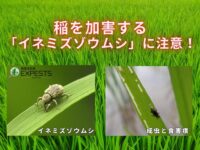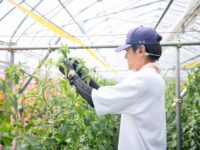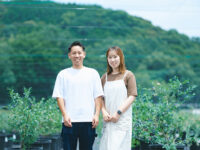Drought Causes Massive Fluctuations in Production
Although half of Australia’s land is designated for agriculture, most of this is grazing land due to the fact that at two thirds of the country are arid regions. Irrigation farming only occurs on 0.5% (*2) of the land.
While driving around by car during the tour, the main scenery was desert-like, brown, dry land, which begged the question “could this really be a major agricultural producer”? The impression was one of very little green land.

Taken from the window of our car – in some areas this kind of landscape continues unchanging for 20min
With regular low rainfall and drought, agricultural production decreases dramatically all over the Australia. Although drought only directly affects the production of cereals like wheat and rice, shortages in cereals for animal feed mean the livestock industry also feels the impact. Apparently, there was a drought year where cereals for animal feed were put aside as a priority, with cereals for human consumption imported instead.
In Queensland’s Goondiwindi, the “Carpendale Group” grows cereals including wheat, barley and chickpeas. At Carpendale, seeds are planted deeper in the earth in an attempt to retain even a little extra moisture. The company also reduced their crops down to one a year from two, based on cultivation costs. Kellie, an employee of the Queensland Government, told us during the tour that sometimes cultivation costs more than profits, and because of this there are some producers that give up on cultivation altogether.

Grain silos at the “Carpendale Group” – other than delivery to the port, the company manages everything from production through to sale
According to Kellie, growers buy sheep to eat the grass on uncultivated land as otherwise it becomes rough and unkempt. When asked what happens to the sheep when the growers restart cultivation of crops, she said that they sell the sheep to make money. Australia and New Zealand vie as the top two countries in the world for sheep meat export(*3), and demand for the meat is also high domestically. It became apparent that there is a system in place that is working.

Happy to eat hay and dry grass, sheep are animals that do well in dry spells
Keeping an Eye on Water Management
Due to its rich soil and the fact that it is relatively easy to secure water for agriculture, the state of Queensland holds 32% of the domestic production value of vegetables produced through irrigation farming(*4). Compared to cereals, which must rely on rainfall for their production, irrigation farming is said to be less susceptible to drought, meaning that the stable production of vegetable is predictable and reliable.

A field of broccoli at “Moonrocks” where they let us taste some product harvested on the spot – it was amazingly succulent
Having said this, irrigation farming is not completely immune to the effects of drought. On visiting the producers themselves, we found land set-up in different ways to effectively manage water.
Major St George vegetable grower “Moonrocks” has direct contracts with Australia’s major supermarket chains and its products support consumption on a national scale. With water running close to their land, the company works in cooperation with other growers to establish rules and share the use of the water. In order to use this precious resource without waste, the company has set up automatic irrigation pipes throughout their fields, and they manage these through a system utilising computer technology.
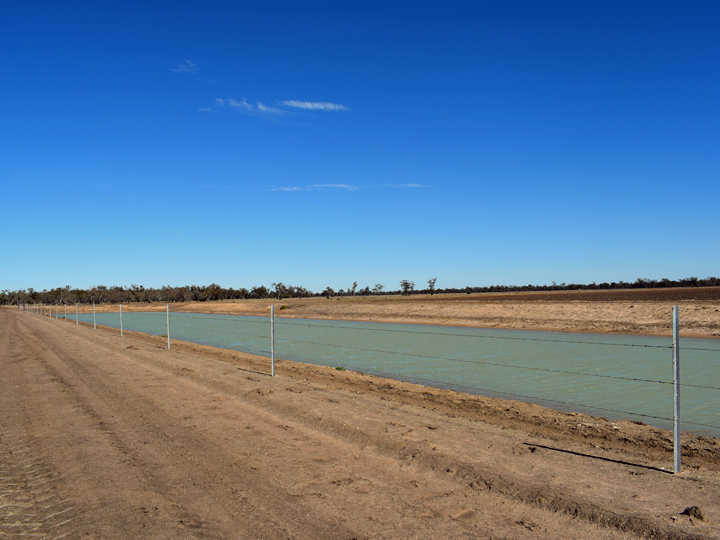
A river near the fields – when we asked if they ever broke the rules, the reply was that there was nothing worth having enough to betray friends and neighbours for
In the same way, “Riversands Vineyards” in St George grows grapes using Israeli sprinkling equipment. They bought equipment suited to their land and product based on discussions with a specialist agriculture consultant. The company’s owner, David, told us “water management systems are really important so I compared a lot of different options.”
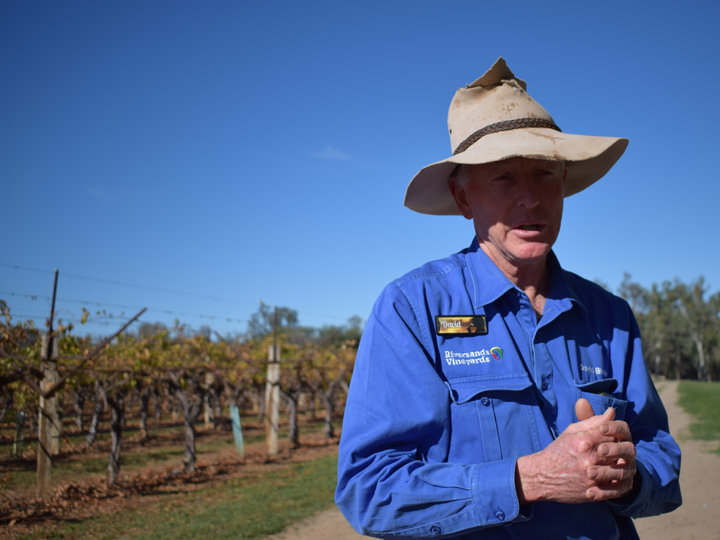
Owner of “Riversand Vineyards”, David – they skilfully cultivate different types of grapes for wine and for consumption by planting the crops at different times

The orange tank is equipment for sprinkling
Farms, Government and the Private Sector Working Together to Tackle Problems
While growers have a variety of ways of managing their water, domestic “agri tech” companies are also working in the field. Goondiwindi company “infarm” offers a number of services aimed at growers, for example an image analysis service utilising AI technology. The company is currently conducting a proof-of-concept trial in Israel using satellites for field diagnosis and, if successful, they will be able to access a range of detailed data about crops including things like moisture levels. This sort of information can then be used to grow crops with the minimum amount of water required.
infarm’s managing director Jerome enthusiastically tells us, “Israel is similar to Australia in that it’s dry and doesn’t get a lot of rain. By cooperating together I want to be able make a contribution to the agriculture of both our countries.”

Jerome from “infarm” – he also runs a service utilising drones
As close to 70% of Australia’s water is used for agriculture, the cooperation of citizens is also needed to conserve water during droughts(*5). Starting with the National Water Commission Bill in 2004, the Australian Government has worked to efficiently, and effectively, manage the country’s water resources including the amendment of the Water Act in 2007. There is much Japan could learn from Australia. We found that the Australian government is involved in a number of measures to combat drought including improving varieties of plants that are resistant to changes in climate.
Finding New Business Opportunities in our Differences

Meetings with local companies during the tour – many Australian companies have a morning and afternoon teatime at about 10am and 3pm
Here we come to the end of three articles reporting on our Queensland Agriculture Tour. The first article gave an overall picture of the scale of agriculture in Australia the country’s main crops, and the second reported on consumer trends in both Australia and internationally based on products we saw in supermarkets and on farms. In this article we have focused on the biggest issue facing Australian agriculture – drought.

Visiting the fields of St George cotton producer “Rogan Pastoral Company” – the white mass is harvested cotton
During the tour, and while writing these, articles we were constantly reminded of how different things in Australia are to Japan. These differences mean that the Australian agricultural industry must surely be full of new business opportunities for Japan’s growers and agricultural companies (and, of course, this also works the other way around). Going forward, Mynavi Agri will continue to deliver reports on what is happening in other countries, always with a focus on finding the “difference”.
※1 Cited from JETRO Agriculture and Fisheries Department “2008 Consultant Report on the Current State of Agricultural Product Production and Policy in Australia” (Japanese only).
※2 Cited from ABS(Australian Bureau of Statistics)「Agricultural Commodities, 2007-2008」.
※3 Food and Agriculture Organization (FAO), 2012.
※4 Cited from ABARES(Australian Bureau of Agricultural and Resource Economics and Sciences)「Australian vegetable growing farms: an economic survey, 2007-08」.
※5 Cited from ABS「Water Account, Australia, 20004-05」.
For further information:
“Australian agriculture and water trade through water market” (2011) Nobumasa Hatcho and Yutaka Matsuno











